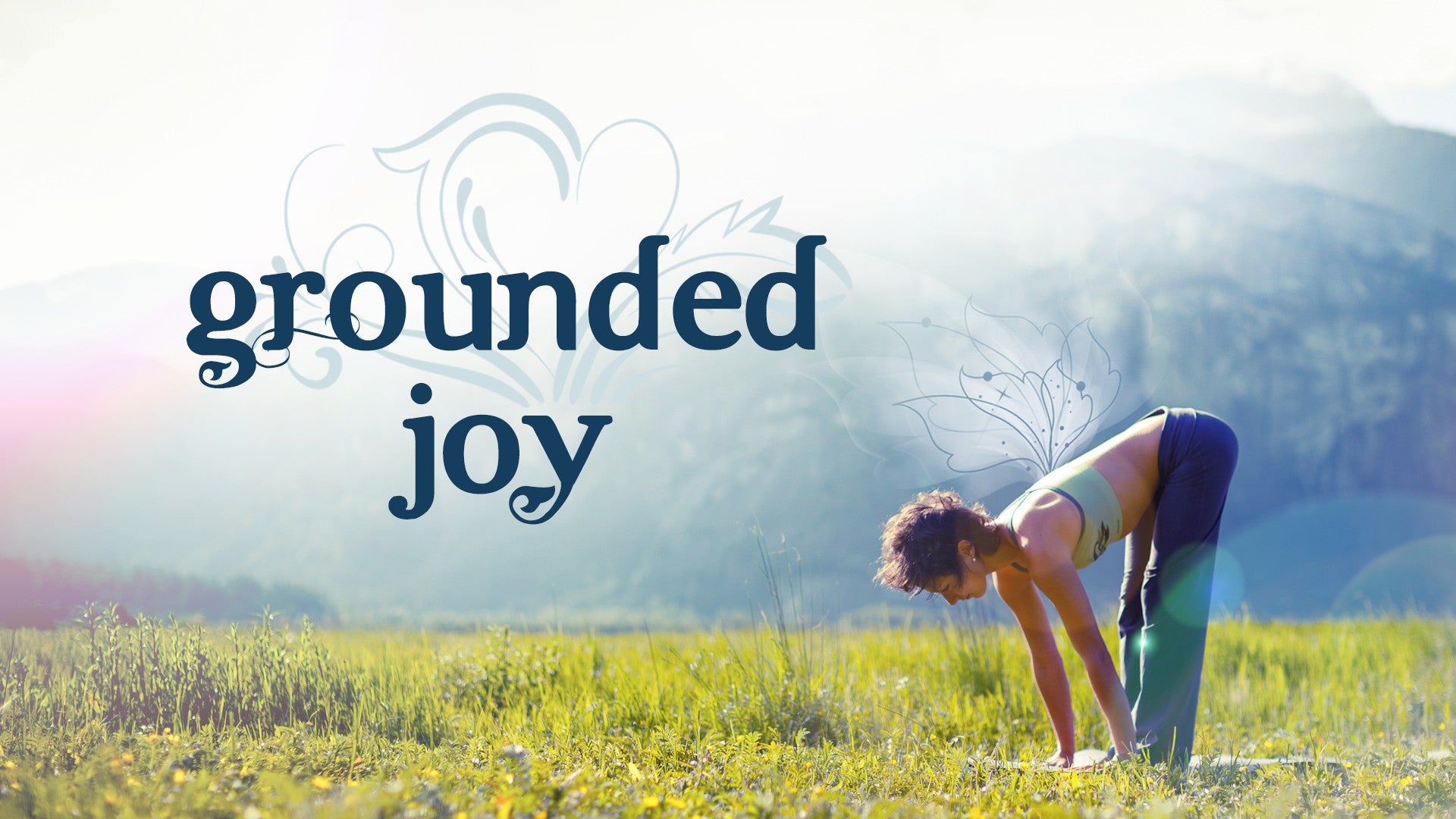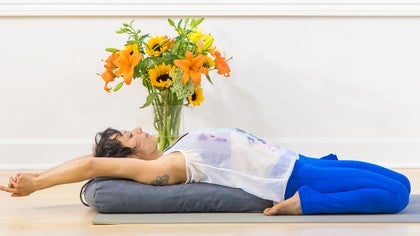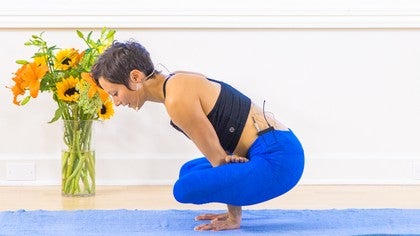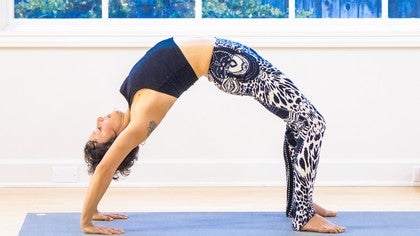Description
About This Video
Transcript
Read Full Transcript
(water crashing) Hey. Thanks for showing up here. This is a little, short nugget on Mandalasana. And Mandalasana is a circular like movement and you can enter it from three postures. And those three postures sort of progress in difficulty.
Setu Bandhasana, which we'll look at, Shirshasana and Urdhva Dhanurasana. So bridge pose, head stand, shoulders, and full wheel pose. I wouldn't recommend doing this practice unless you're really quite warm. So if you want to try it out with me, you could check out the standing sequence that I do, or even one of the backbend practices. And before you do a counterpose, like a forward fold or the leg stretches, you could insert this one in.
In fact, this one is a gorgeous practice to do at the end of deep back bending if you're a deep back bender because it so gloriously opens up your side body and your psoas muscles and all the buttressing of the spine on both sides. It's quite a deep side body lengthener, so lateral spine opener, and also it's a pretty deep lumbar twist. So let's look at some openings that may help the progression of this play. You may need, you will need, a bolster or some pillows and a block or a stack of books. So we're going to start off with the bolster.
And I'm going to slide it out, going to come under my back, press into my feet, pick up the bolster, and slide the bolster so that it comes to the edge of my right hip. Then I'm going to press into my elbows, put my hands on the bolster, pick up my hips like I was going to go into a shoulder stand and do a little hip flip so that I come onto the outer right hip like that. And then I'm gonna bend my knees and let my legs fall off of the bolster towards the floor. So your knees might not come all the way down. You could take a block or put some blankets underneath to support.
But I'm still on the bolster with my right hip. And then I'm gonna get a sense of leaning this left hip away from me. May be better to do with my right hand. And I feel a lot of stuff happening there in my left side. Opening of the hip, opening of the QL area, the oblique area, the spiral line, it's opening up.
You could straighten your legs out here if you like and activate them a little bit. And then I actually have more space and I can roll open. And my mid back isn't touching the floor, so sometimes I like to press into my elbow and rotate into the twist a little bit more. And I'm careful not to just crank my ribs away from my lumbar, but actually start the twist from the pelvic floor. It's actually okay if the left leg slides a little away from the right leg like that.
Might give you a bit more space. I'm encouraging this leg away. Okay let's try the other side. Rolling into the center. And that's really deep, so take your time to come out, any little movements.
And we'll switch sides. So I'm gonna shift the bolster to the edge of the left hip. So I'm gonna press down into my elbows. It's like I'm going into a shoulder stand. Do that hip flip.
And let my knees come to the floor. Now if you have any stuff in your sacrum happening and you don't want to overstretch the SI area or it feels tight or maybe one is contracted or overstretched, then you can put a block in between your knees like that. And that might feel really stabilizing because it just allows the sacrum to come in a bit. You could straighten your legs. And you can allow for a little bit of a twist to come into the pelvis.
And then I'm going to use my left hand here to lean away. So it's so much different, you can see in my body, this, contraction on this side, this jacking up of the hip, and then this, my whole side body is just taking a huge breath of fresh air. And then I might go down into my lumbar and twist, twist, twist around. I'm picking my rib cage up a little bit. I can try extending through my heels and my toes.
Moving the pubic bone away from the belly button. Super tenderly come out. Let's just stretch out the legs. Interlock the fingers. Tailbone down towards the heels and get long.
And then we're gonna take the bolster out and replace our friend the bolster with the block. And we're gonna start with coming into Setu Bandhasana, the bridge pose. So lean down into the feet, connect the shoulder blades a little bit down the back, tailbone towards the backs of the knees, rolling up. Stretching the belly, the two sides of the waist. And keep the block within hands reach here.
From here we're gonna come up onto the toes, lift the pelvis a little bit higher and see if you can bring your elbows, kind of rock your shoulders underneath you, getting a little asymmetrical side to side to see if you can get your hands under your hips. Holding the outer hips, or even holding the thumbs right underneath the sacrum. And we're gonna go into the side bridge. So we're gonna keep the shoulders where they are, so pin the shoulders down and then start to shimmy your feet over to the right. And then I'm gonna take the block on that side I'm gonna come high up onto my toes, place the block right under my sacrum.
And I can keep walking the legs a little bit over. I don't wanna compress my right side, I want to keep it pretty long. But there is a shortening of the right side and a lengthening of the left side. Then I'm gonna cross my legs, staying steady in my feet, because it's easy to just let all your weight explode onto the block. So stay steady in your feet, lift your left leg up and cross it over your right.
And to get that cross, you might move the knee in to catch. But once you get it, move the knee back out in line with the hip. You should feel an amazing stretch on your left side. So I can hold onto my hips here. Let my arms go.
Move them in a T position. And breathe. We're going to come back center. It's nice to come here and let your heels together and kind of externally rotate your toes away from each other and move the top rim of your sacrum, so like the line of your pants, down into the block and see what that does. It kind of decompresses your back.
If you tend to overarch there. Okay let's come all the way back into the center. Come high up onto the toes to release the block. Center yourself again and walk over to the other side. Get the block there.
And the block is kind of on a diagonal because you want the block to be supporting the sacrum, the back of the pelvis. So left side is not congested but it's shorter than your right. And then you might let your right leg come up, tip your left knee in, cross and then align the left knee with the hip and that movement is gonna give you a beautiful kidney opening, a beautiful side body opening. Each exhale really can slide up towards the heart. There's still activity in the grounded leg.
And move the top rim of the sacrum as if this was your sacrum down towards the top of the block. And remember that feeling. Okay let's get out of there. It's interesting to note how one side feels different than the other. Roll down.
Bring your knees in, wobble. So with those side openings, let's play with starting to make the mandala, the circular movement. This movement is quite demanding on your wrists, so that flexion in your wrists, you can warm up like this, pressing your fingers together and just opening up the wrists down and away from each other And it's just important to always keep a strong connection to your fingers. So if you're just allowing the weight to come down onto your wrists and your fingers are not alive, it's probably going to put some compression on the joint. So strong fingers, almost like your gripping a ball, or like palming a basketball.
And that's gonna help you come out of your wrists a little bit. So rolling up one vertebrae at a time. The outer hips, you might need to come up. Walk the shoulders in to take the outer hips. Feel the length in your sides here.
And then we're gonna walk over to the side. And I'm gonna turn my right hand, so maybe I need to come up onto my toe pads to hold my hips where the block was. And my hand is like this. I'm going to come up onto my tip toes so I have a bit more space. Take my left leg, it's kind of this movement, but I'm actually going to come high up onto my right tip toes, and I'm gonna turn my right foot, so the toes point towards where my head is and roll over my head.
And then I'm in side plow. And if you've done the shoulder stand sequence with me you know this posture. And I'm pretty much in the same position that I was on the bolster and I can see if I compress my side or lengthen it. Okay let's go all the way around. So now we're in the plow.
All the way into the side plow. Pin the elbow down, prepare to take a hold of the left pelvis. So side plow. And then this movement is tricky. I find it trickier moving over this way than what we just did.
So we come high up onto the left toes. I'm gonna get my hand ready to hold the side buttock. And bend that knee and start to turn the toes towards the front of the room and then hoofer into the side bridge. And then I'm gonna walk all the way around strong in the fingers. So we can try it the other way, and this time I'm not going to say anything.
You can just try it. I didn't talk too much about the position of the head but the head doesn't move too much. I mean the eyes might move a little bit to see what's happening but the head doesn't move too much, rolls side to side. Now I'm just gonna give you a sense of that kind of movement in the next two postures. I'm just gonna move these over to the side because I might kick them.
So Shirshasana, position with the hands. I like a loose clasp in the fingers, feeling a grip. And then the elbows in a wider than the shoulders. Catch the outer skin of the elbows. Place the head.
So I just come like I'm going to go up but I don't go up. And I walk over to the side. And I'm gonna turn my toes and the whole leg in towards my body and I'm just gonna let my left leg reach out and bend it and think about going over and sort of dropping my foot to the floor. I'm gonna come around to the other side. This posture's sort of creature-esque.
So I'm turning the toes in towards the mat, and that's turning my hip in. And I want to think about not compressing this left side too much because of course the lengthening is coming into my right side here, but I want to stay long in that left side. Without collapsing my shoulders. And so you might have fear come up there. Like when you think like, how would I possibly do that?
And the truth of this posture is the slower you do it, perhaps the more tension is going to be in the posture. And it is one of those things that needs to be done a little bit quicker. And sort of a little bit more relaxed. But of course the foundation and the strength have to be there. And the length in the lower spine.
I'm gonna show you the drop over, relaxed and a little bit quicker. And this is just an interesting thing when you come up against fear in your practice, it tightens you but it's there for a reason. It's necessary and you learn so much from it and without doubt and without fear, there might not be awakenings, there might not be too much learning. So. So why don't we take a look at Urdhva Dhanurasana and what that might look like.
So coming into your Urdhva. And this might be useful to watch first because when you're upside down and backwards, you might not know what I'm talking about. So you can always pause the video and try after you see what's happening. Lengthening the lower back, sacrum in and up. Okay so when we come over to one side, the side that I'm coming over on to, my elbow's gonna bend.
And it's always this play of not overshortening my right side here and lengthen and overlengthening my left. So I want to keep this sense of control in my core, in my midline. It's because I'm turning my toe in, I'm turning the hip in. Okay so just feel that. And then over to the other side, bending the side that I'm going towards.
And I'm really looking a little bit towards my elbow here. And that leg is imagining what it would do if it was to come over and down. You'll feel in this that there's, once you turn the bottom hip, the top hip flips on top of the bottom hip. It's a little bit like, that feeling. So let me show you what it looks like.
Sometimes it's not so pretty. Because I'm not going to worry about it being pretty. I'm going to relax enough with a breath that creates enough core control that I support but that I'm relaxed so that the movement can have a little bit of momentum behind it. So as soon as I stop in that movement, I don't have that fluidity of momentum. And I could fall out or it could just not feel as nice in my body.
So let me come a little closer here. Bending. So for me, if I do a deep back bend practice, I'm now sort of craving to do some sort of movement like that after. For one I'm warm enough to get the fluidity of it, and there's something with that fear and making a quicker movement. Although it's not for everybody.
Thank you so much for watching and joining me with that. Namaste.
Grounded Joy
Comments
You need to be a subscriber to post a comment.
Please Log In or Create an Account to start your free trial.









